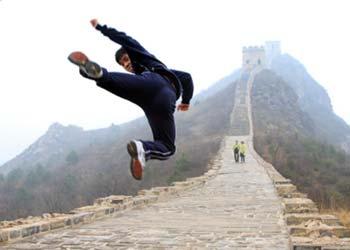Source:
01-19-2009 14:54
The original Chinese word Gongfu was popularized in the western world as Kung Fu by the legendary Bruce Lee. Kung Fu became synonymous with the Chinese martial arts. His 1973 film ‘Enter the Dragon’ popularized the martial art like never before becoming in the process an international box office hit.
 |
| Kung Fu in Culture, Chinese |
Ironically it was not a hit in the Hong Kong box office where another comedy film ’72 Tenants’ stole the show. Notwithstanding this, Bruce Lee can be considered one of the greatest masters of Kung Fu Cinema. The Kung Fu culture encouraged another great movie ‘Shaolin Temple’ (1976) by the Chinese director Chang Cheh.
This is a classic movie in the sense that it focused on the temporal dimension of the Kung Fu art in contrast to the skills that were in focus in the Bruce Lee film. Similar expression of the temporal dimension of Kung Fu was also displayed in the Shaw Brothers Studio productions in the 1970s and 1980s. In the film ‘Shaolin Temple’, it has been conveyed that the Kung Fu characteristics of patience and perseverance can with the flow of time attain the apparently impossible. In the story, the temple disciples with years of repetitive labor like cooking and carrying water gradually acquire Kung Fu skills without their knowing it. Many people complain that the Hollywood versions of Kung Fu have ignored this temporal aspect of discipline and trial and instead exaggerated fighting and violence with an eye to creating spectacles only and not characters and plots.
This deficiency in projecting the appropriate culture of Kung Fu has somewhat been restored by the 2005 movie ‘Kung Fu Hustle’ by Stephen Chow. In fact the Chinese title he gave to the film is ‘Gongfu’. A profound knowledge of Kung Fu tradition along with the modern socio-political and economic concerns of China has been cinematically crafted to make this “Ultimate Kung Fu Film”.
The place of morality in the traditional culture of Kung Fu has surely found its place in this film.
Kung Fu or the Chinese martial arts have found place in popular culture from historic times. It had influenced the ancient Chinese Opera, a form of drama as old as the Tang Dynasty. In Chinese Opera are exhibited the martial arts movements integral to Chinese culture and often martial artists perform in these operas.
Fictional accounts of martial arts in literature date back to 2nd and 3rd century BC and were later popularized by the Tang and Ming Dynasties. The genre of literature depicting martial arts is known as ‘wuxia’. The popular perceptions about martial arts are still influenced by these literatures. From the 1970s, Kung Fu in popular culture has spread from books to the wider audience of TV shows and cinemas. This could take the Chinese martial arts or Kung Fu to a global level transcending its ethnic roots.
After the Bruce Lee film, there came floods of martial arts films popularized in the west by Hollywood. Earlier the North American TV series ‘Kung Fu’ in the early 70s popularized the art on television. The practice and philosophy of Chinese martial arts portrayed in this series brought before the world the popular culture of China. The TV series ran for three years showing 60 episodes.
The Kung Fu genre has been further popularized by the Chinese martial arts movies (popularly called Kung Fu movies) by the present day actors and martial artists like Jackie Chan and Jet Li. These movies have created a cultural genre known as ‘Kung Fu Theater’. The modern TV action series depict martial arts focusing on violence and spectacle without portraying the true philosophies behind this art.
Editor:Yang Jie
